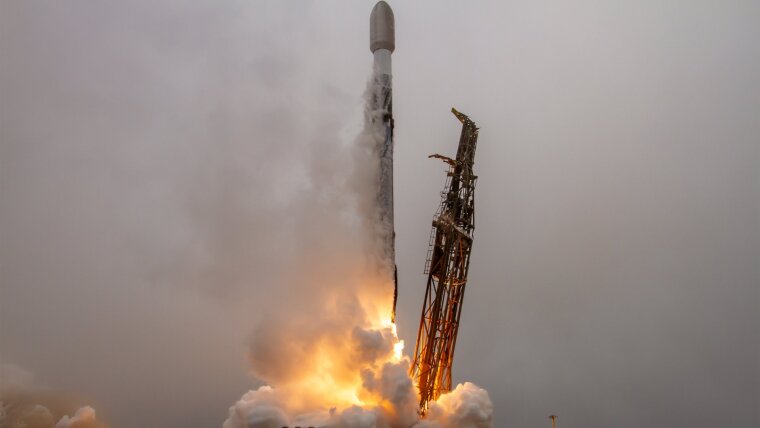
- Light
- Knowledge Transfer and Innovation
- Research
Published: | By: Julia Rinner
Yesterday, Monday (23 June), the QUICK³ nanosatellite was launched into space from Vandenberg, California, on a carrier rocket. The satellite, which is part of a research consortium from Germany, Italy and Singapore, will be used to test components for the construction of a quantum satellite system in space in order to enable fast and tap-proof quantum-based communication in the future.
The QUICK³ satellite is no bigger than a shoe box and weighs around four kilograms. Its mission: to test components for quantum communication in order to transmit data from the sender to the recipient in a completely tap-proof manner. Unlike traditional communication via fibre optic cable, the information sent by a quantum communication satellite is not contained in light pulses made up of many photons, but in individual, precisely defined light particles. These are in so-called quantum states, which make the transmission of data absolutely secure. Every tapping attempt changes the state of the photons and is therefore recognized immediately.
As the individual light particles cannot be copied or amplified, their range in optical fibres is limited to a few hundred kilometres. Satellite-based quantum communication therefore utilizes the special properties of the atmosphere: in higher layers of air, the light is hardly scattered or absorbed—ideal conditions for secure data transmission over long distances.
In order to be able to use quantum communication in everyday life in the future, several hundred satellites are required, which are stretched across the earth like a network. However, the QUICK³ mission is first intended to show whether the individual components of the nanosatellite can withstand the conditions in space and interact successfully with each other. In addition to researchers from the Technical University of Munich, the QUICK³ satellite was largely developed together with scientists from Friedrich Schiller University Jena, the Ferdinand-Braun-Institut, Leibniz-Institut für Höchstfrequenztechnik and Technische Universität Berlin, together with international partners at the Institute for Photonics and Nanotechnologies in Italy and the National University of Singapore.
QUICK³ nanosatellite uses single photon source instead of laser beams
»We are testing single-photon technology for micro-satellites for the first time on this mission,« says Tobias Vogl from the Technical University of Munich, who is leading the project and launched it at the University of Jena in 2021. »There is currently no comparable project anywhere in the world. Either the satellites are significantly heavier and therefore more expensive or the satellites are laser-based, which considerably reduces the data rate. The transmission speed is an important advantage of our system, as satellites only have visual contact with the ground stations for a few minutes per orbit.«
The second objective of the mission is to test the so-called Born probability interpretation of the wave function in zero gravity. This describes the probability with which a quantum particle will be found at a certain location during a measurement—a central concept of quantum mechanics. Whether this rule also applies without restriction under space conditions has not yet been tested experimentally.
Background
- The QUICK³ mission is an international research project involving researchers from Friedrich Schiller University Jena, Humboldt-Universität zu Berlin, Technische Universität Berlin, the Ferdinand-Braun-Institut, Leibniz-Institut für Höchstfrequenztechnik and the Institute for Photonics and Nanotechnologies in Italy, as well as the National University of Singapore.
- The quantum light source was built by the teams at TU Munich and the University of Jena and integrated with an optical chip from the Institute for Photonics and Nanotechnologies in Italy. The Ferdinand-Braun-Institut, Leibniz-Institut für Höchstfrequenztechnik built a laser system to excite the quantum light source, which is controlled by electronics from the National University of Singapore. The TUB was responsible for the experiment control in space as well as the interfaces between the payload and the satellite.
- The project is funded by the German Federal Ministry for Economic Affairs and Energy.